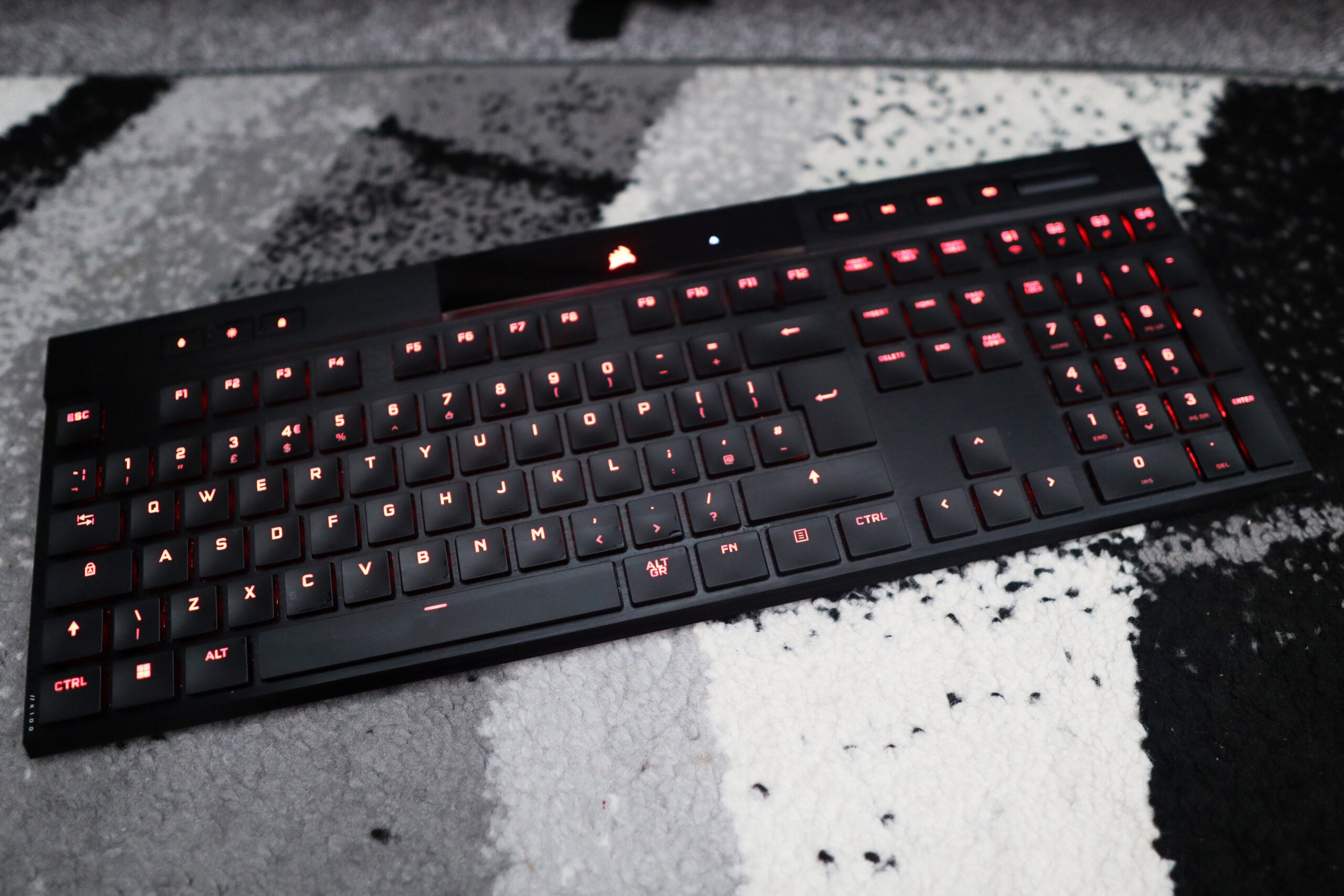Verdict
The Corsair K100 Air Wireless is undoubtedly one of the best (and most expensive) wireless gaming keyboards money can buy. It’s incredibly slim and offers a modern aesthetic alongside snappy and tactile MX ULP switches that feel fantastic for both typing and gaming. In addition, 50 hours of battery life is pretty decent, and the RGB backlighting is vibrant. Just note its high markup only makes it a worthwhile purchase if money is no issue.
Pros
- Incredibly slim
- Snappy and tactile ULP switches
- Vibrant lighting
- Clever software
Availability
- UKRRP: £279.99
- USARRP: $279.99
- EuropeRRP: €299.99
Introduction
The way modern tech has been going, it would be easy to assume that the slimmer the product, the better it is, and in the world of gaming keyboards, that’s certainly looking to be the case.
First, there were low-profile keyboards, such as Logitech’s G915 Lightspeed, or Cherry’s MX Board 10.0, but now there’s a new term in town: Ultra Low Profile.
These types of Ultra Low Profile switches have only been seen in high-end gaming laptops, but they’re beginning to make their way into desktop keyboards – enter the Corsair K100 Air Wireless.
At £279.99/$279.99/€299.99, this may well be the most expensive keyboard I’ve ever tested, so the K100 Air Wireless definitely has to do a lot to justify that high price.
Design
- Wonderfully slim
- Sturdy build with metal top plate
- Addition of macro keys is handy
The most striking thing about the new Corsair K100 Air Wireless is simply how thin it is. Traditionally, gaming keyboards have been these massive bulky behemoths that would take up most of your desk, but this new option from Corsair takes things to a new level of slenderness. They say it’s 11mm thin at its narrowest point, which is testament to how sleek and modern it looks – that’s slimmer than a lot of lifestyle-oriented desktop sets.
Outside of being so thin, the K100 Air Wireless also just generally looks and feels excellent. It features a standard issue full-size layout, which is ultra convenient, and thanks to the slim build, doesn’t take up too much space compared to standard size keyboards. In addition, its metal top plate offers great structural rigidity, with no deck flex whatsoever.
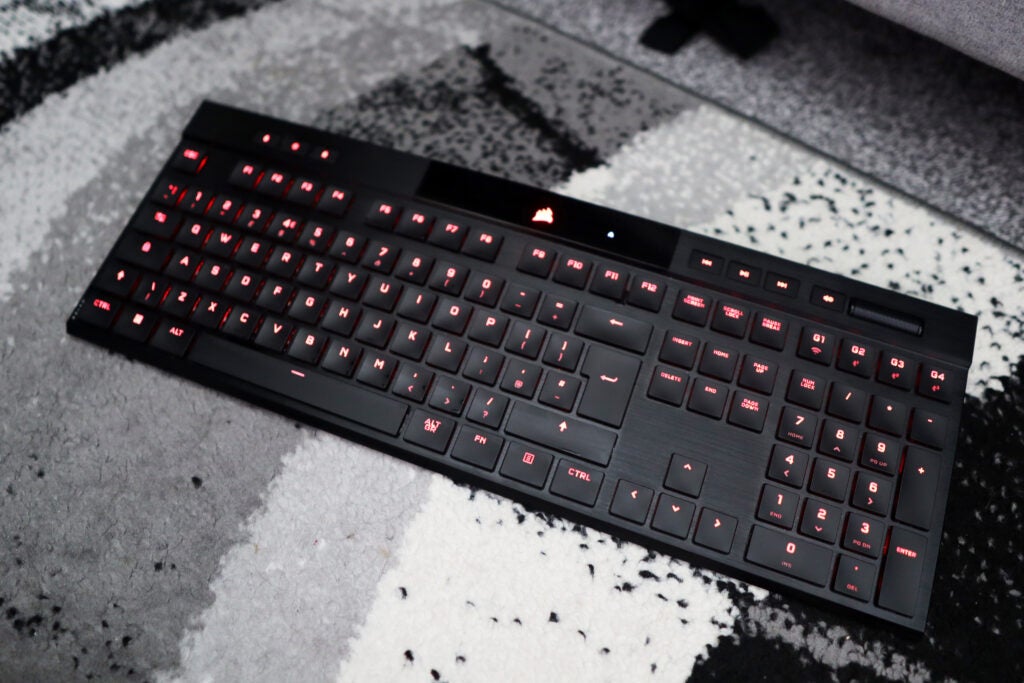
It’s a minimalistic looking keyboard, especially with its narrow construction and black metal top plate. Apart from the RGB lighting (when it’s on), the K100 Air Wireless doesn’t scream that it’s a gaming keyboard. With that in mind though, it comes with four programmable macro keys above the number pad. Although, with the rise of clever software suites, physical macro keys have become more of a rarity, even on higher end keyboards.
As well as these four macros, the K100 Air Wireless features a host of keys for media playback on the right-hand side, as well as a volume roller, which feels satisfying to press. On the left-hand side sit a few shortcut keys for functions such as changing the lighting brightness and locking your PC. In the middle of these sits a small glass panel, underneath which sits an illuminated Corsair logo as well as some handy LED indicators for things such as connection status and when the battery charge level is low. It’s a clever way of doing things, and is executed especially well on the K100 Air Wireless.
Performance
- MX ULP switches feel excellent
- Wireless connection is especially solid
- 50 hours of battery life provides plenty of playtime
Apart from being so thin, the main motivation for someone picking up the K100 Air Wireless is down to its Cherry MX Ultra Low Profile key switches. This Corsair entry marks the first time they’ve been placed in a keyboard, at least in a mainstream capacity. Cherry designed these switches with laptops in mind, but it’s exciting to see them being used in more of a desktop-style capacity.
If you’re sitting there thinking Cherry already made low profile switches, well, you’d be right – the Cherry MX Low Profiles exist, and have done for a few years. But, these MX ULP switches (as I’ll refer to them from now on) are a little bit different.
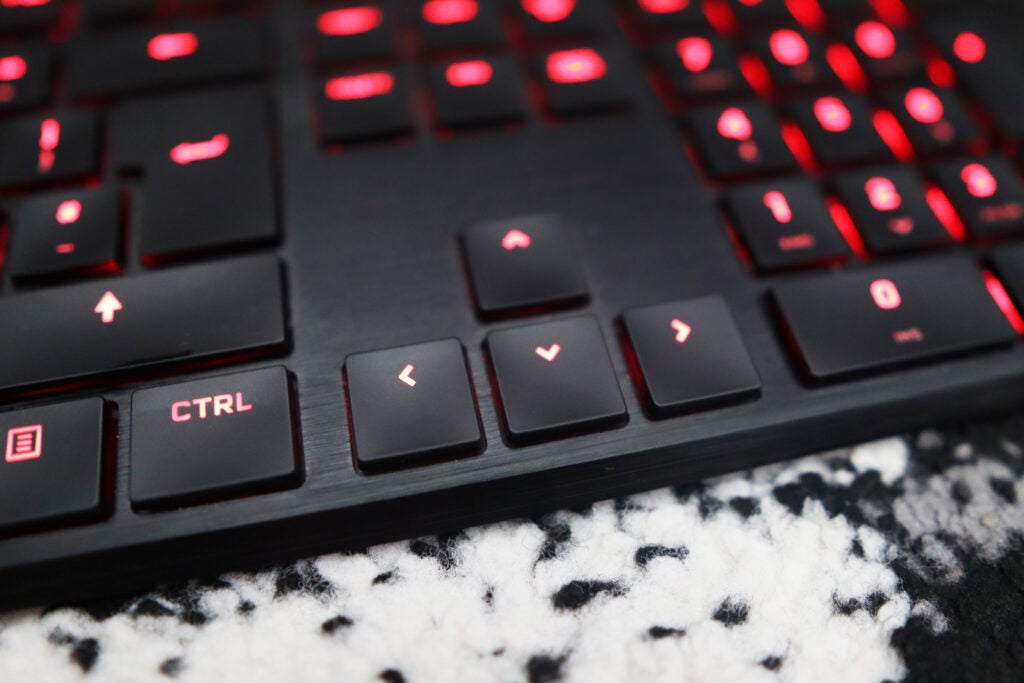
As opposed to offering a standard MX stem style switch, which uses a plastic plunger as the actuator onto the switch’s crosspoints, these ULP switches offer metal ‘wings’, which push down onto the actuator and onto the switch’s crosspoints. It’s a clever system that results in a switch with a total travel of 1.8mm, which is 45% of the total height of a standard MX switch.
With low-profile switches, the travel can sometimes feel a little too short for the full tactile feeling to be experienced, but that isn’t the case with K100 Air Wireless’ ULP switches. Sure, the tactile bump offered by these switches is short and sharp compared to the more rounded tactility offered by taller, standard size switches, but they feel brilliant.
An actuation force of 65cN makes them some of the heavier switches out there (equivalent to MX Clears, for instance) which would usually result in your hands feeling fatigued after a session of typing. Given the short overall travel distance afforded by the ULPs though, that isn’t the case.
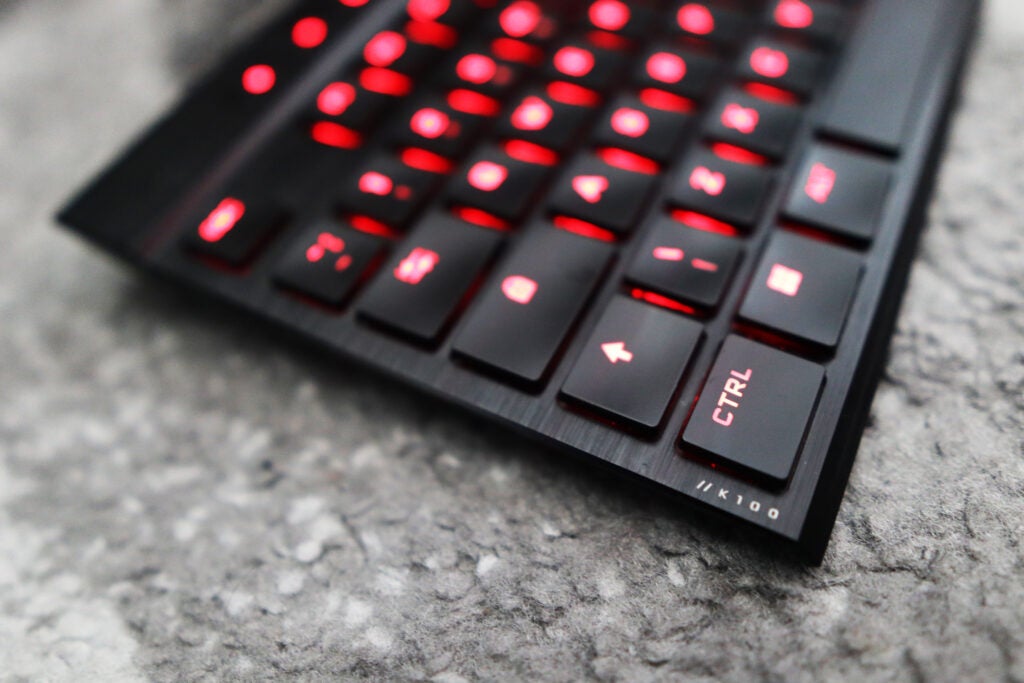
Everything with them has been nicely balanced to offer a satisfying and responsive keypress for typists and gamers alike. In testing the K100 Air Wireless in a few rounds of CS:GO and Apex Legends, it felt sublime with that short travel and tactile keypress. Usually a light and linear switch is the way to go for gamers, but this K100 Air Wireless may make people rethink that decision.
The K100 Air Wireless isn’t just responsive thanks to switches, but also due to the fact it features Corsair’s Slipstream wireless tech, which offers a practical zero-latency connection. You can also use it via Bluetooth, which is as convenient as you’d expect, or via the bundled USB-C cable for charging.
Speaking of responsiveness, much like the standard K100 with MX Speed Silvers or Corsair’s own opto-mechanical switches inside, this Air Wireless version is bundled with Corsair’s Axon hyper processing tech, which means it features a much higher polling rate than more standard keyboards.
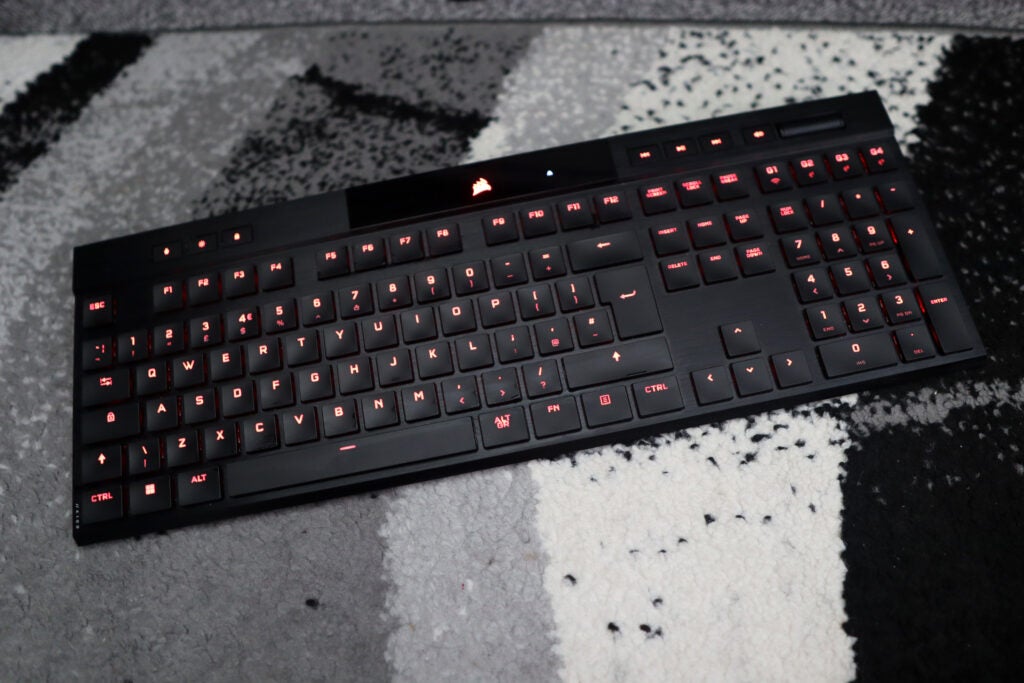
This is only accessible when you’re using the K100 Air Wireless in its wired form, which may defeat the object of it being a wireless keyboard, but it’s still a fantastic addition. It may not be a piece of tech mere mortals can appreciate fully, but competitive gamers should relish the fact it’s here, as well as more standard trimmings like full anti-ghosting and NKRO, too.
A quoted battery life of 50 hours with the RGB lighting fully cranked up is excellent, and in testing, I managed to get a full week’s worth of charge out of the keyboard, working for 8 hours a day in the week, and using the K100 Air Wireless for a couple of hours’ gaming in the evening. Even at especially low battery percentages, it felt like the board just wouldn’t run out of juice.
Software and lighting
- Sharp and vibrant RGB lighting
- iCUE software suite offers amazing levels of customisation
On the Corsair K100 Air Wireless, the RGB lighting in its pre-configured form looks fantastic with bright colours from right across the spectrum.
When it comes to software, the K100 Air Wireless ships with a brand new version of Corsair’s already excellent iCue suite, which has itself received a fresh lick of paint to look like a more modern software solution.
There’s a lot to unpack with it in conjunction with the K100 Air Wireless, with options to not only assign keys to different functions, but also to configure lighting, with both presets and custom options available. Programming those lighting presets also works on a hardware level, with up to 20 different layers available, which is especially clever.
Alongside these options, there are also more mundane (but still important!) tasks such as updating firmware and assigning profiles, demonstrating that you’re getting the complete software solution with the pairing of iCue and the K100 Air Wireless.
Latest deals
Should you buy it?
You want the powers of Ultra Low Profile switches:
The K100 Air Wireless comes with some of the snappiest key switches I’ve ever used in a keyboard.
You want something affordable:
As much as it’s an amazing board, there’s no getting around the fact that the K100 Air Wireless is very expensive. If you’ve got the money though, definitely consider it.
Final Thoughts
The world of low-profile keyboards is becoming more popular, and to see them get to the levels of sleekness afforded by ultra low profile switches with the likes of the Corsair K100 Air Wireless is amazing. It’s definitely one of the best gaming keyboards I’ve used full stop, with a large part of that aided by its Tactile ULP switches. They offer a sharp and snappy keypress alongside a superb sense of tactility often lost with shorter-travel switches.
This is also a keyboard that’s gorgeously slim with a total height of 17mm, and offers vibrant RGB lighting, a reliable wireless connection, and some handy software. It’s a fantastic keyboard with no gimmicks, but that price is especially hard to stomach at the best of times, not least when we’re in a cost of living crisis.
How we test
We use every keyboard we test for at least a week. During that time, we’ll check it for ease of use and put it through its paces by playing a variety of different genres, including FPS, strategy and MOBAs.
We also check each keyboard’s software to see how easy it is to customise and set up.
FAQs
Yes, it can be connected wirelessly via both Bluetooth and the wireless dongle.
The keyboard features Cherry MX ULP Switches, which were initially designed for laptops.
Sustainability
TrustedReviews’ holds the fact that global warming is not a myth as a core value and will continuously endeavor to help protect our planet from harm in its business practices.
As part of this mission, whenever we review a product we send the company a series of questions to help us gauge and make transparent the impact the device has on the environment.
We currently haven’t received answers to the questions on this product, but will update this page the moment we do. You can see a detailed breakdown of the questions we ask and why in our sustainability info page.
Jargon buster
RGB
RGB stands for Red Green Blue, and essentially means a device is capable of producing colourful lighting, rather than just a white light. It’s often found on gaming peripherals such as mice and keyboards.
Opto-mechanical Switches
Mechanical keyswitches that operate through lasers as opposed to traditional springs
Verdict
The Corsair K100 Air Wireless is undoubtedly one of the best (and most expensive) wireless gaming keyboards money can buy. It’s incredibly slim and offers a modern aesthetic alongside snappy and tactile MX ULP switches that feel fantastic for both typing and gaming. In addition, 50 hours of battery life is pretty decent, and the RGB backlighting is vibrant. Just note its high markup only makes it a worthwhile purchase if money is no issue.
Pros
- Incredibly slim
- Snappy and tactile ULP switches
- Vibrant lighting
- Clever software
Availability
- UKRRP: £279.99
- USARRP: $279.99
- EuropeRRP: €299.99
Introduction
The way modern tech has been going, it would be easy to assume that the slimmer the product, the better it is, and in the world of gaming keyboards, that’s certainly looking to be the case.
First, there were low-profile keyboards, such as Logitech’s G915 Lightspeed, or Cherry’s MX Board 10.0, but now there’s a new term in town: Ultra Low Profile.
These types of Ultra Low Profile switches have only been seen in high-end gaming laptops, but they’re beginning to make their way into desktop keyboards – enter the Corsair K100 Air Wireless.
At £279.99/$279.99/€299.99, this may well be the most expensive keyboard I’ve ever tested, so the K100 Air Wireless definitely has to do a lot to justify that high price.
Design
- Wonderfully slim
- Sturdy build with metal top plate
- Addition of macro keys is handy
The most striking thing about the new Corsair K100 Air Wireless is simply how thin it is. Traditionally, gaming keyboards have been these massive bulky behemoths that would take up most of your desk, but this new option from Corsair takes things to a new level of slenderness. They say it’s 11mm thin at its narrowest point, which is testament to how sleek and modern it looks – that’s slimmer than a lot of lifestyle-oriented desktop sets.
Outside of being so thin, the K100 Air Wireless also just generally looks and feels excellent. It features a standard issue full-size layout, which is ultra convenient, and thanks to the slim build, doesn’t take up too much space compared to standard size keyboards. In addition, its metal top plate offers great structural rigidity, with no deck flex whatsoever.

It’s a minimalistic looking keyboard, especially with its narrow construction and black metal top plate. Apart from the RGB lighting (when it’s on), the K100 Air Wireless doesn’t scream that it’s a gaming keyboard. With that in mind though, it comes with four programmable macro keys above the number pad. Although, with the rise of clever software suites, physical macro keys have become more of a rarity, even on higher end keyboards.
As well as these four macros, the K100 Air Wireless features a host of keys for media playback on the right-hand side, as well as a volume roller, which feels satisfying to press. On the left-hand side sit a few shortcut keys for functions such as changing the lighting brightness and locking your PC. In the middle of these sits a small glass panel, underneath which sits an illuminated Corsair logo as well as some handy LED indicators for things such as connection status and when the battery charge level is low. It’s a clever way of doing things, and is executed especially well on the K100 Air Wireless.
Performance
- MX ULP switches feel excellent
- Wireless connection is especially solid
- 50 hours of battery life provides plenty of playtime
Apart from being so thin, the main motivation for someone picking up the K100 Air Wireless is down to its Cherry MX Ultra Low Profile key switches. This Corsair entry marks the first time they’ve been placed in a keyboard, at least in a mainstream capacity. Cherry designed these switches with laptops in mind, but it’s exciting to see them being used in more of a desktop-style capacity.
If you’re sitting there thinking Cherry already made low profile switches, well, you’d be right – the Cherry MX Low Profiles exist, and have done for a few years. But, these MX ULP switches (as I’ll refer to them from now on) are a little bit different.

As opposed to offering a standard MX stem style switch, which uses a plastic plunger as the actuator onto the switch’s crosspoints, these ULP switches offer metal ‘wings’, which push down onto the actuator and onto the switch’s crosspoints. It’s a clever system that results in a switch with a total travel of 1.8mm, which is 45% of the total height of a standard MX switch.
With low-profile switches, the travel can sometimes feel a little too short for the full tactile feeling to be experienced, but that isn’t the case with K100 Air Wireless’ ULP switches. Sure, the tactile bump offered by these switches is short and sharp compared to the more rounded tactility offered by taller, standard size switches, but they feel brilliant.
An actuation force of 65cN makes them some of the heavier switches out there (equivalent to MX Clears, for instance) which would usually result in your hands feeling fatigued after a session of typing. Given the short overall travel distance afforded by the ULPs though, that isn’t the case.

Everything with them has been nicely balanced to offer a satisfying and responsive keypress for typists and gamers alike. In testing the K100 Air Wireless in a few rounds of CS:GO and Apex Legends, it felt sublime with that short travel and tactile keypress. Usually a light and linear switch is the way to go for gamers, but this K100 Air Wireless may make people rethink that decision.
The K100 Air Wireless isn’t just responsive thanks to switches, but also due to the fact it features Corsair’s Slipstream wireless tech, which offers a practical zero-latency connection. You can also use it via Bluetooth, which is as convenient as you’d expect, or via the bundled USB-C cable for charging.
Speaking of responsiveness, much like the standard K100 with MX Speed Silvers or Corsair’s own opto-mechanical switches inside, this Air Wireless version is bundled with Corsair’s Axon hyper processing tech, which means it features a much higher polling rate than more standard keyboards.

This is only accessible when you’re using the K100 Air Wireless in its wired form, which may defeat the object of it being a wireless keyboard, but it’s still a fantastic addition. It may not be a piece of tech mere mortals can appreciate fully, but competitive gamers should relish the fact it’s here, as well as more standard trimmings like full anti-ghosting and NKRO, too.
A quoted battery life of 50 hours with the RGB lighting fully cranked up is excellent, and in testing, I managed to get a full week’s worth of charge out of the keyboard, working for 8 hours a day in the week, and using the K100 Air Wireless for a couple of hours’ gaming in the evening. Even at especially low battery percentages, it felt like the board just wouldn’t run out of juice.
Software and lighting
- Sharp and vibrant RGB lighting
- iCUE software suite offers amazing levels of customisation
On the Corsair K100 Air Wireless, the RGB lighting in its pre-configured form looks fantastic with bright colours from right across the spectrum.
When it comes to software, the K100 Air Wireless ships with a brand new version of Corsair’s already excellent iCue suite, which has itself received a fresh lick of paint to look like a more modern software solution.
There’s a lot to unpack with it in conjunction with the K100 Air Wireless, with options to not only assign keys to different functions, but also to configure lighting, with both presets and custom options available. Programming those lighting presets also works on a hardware level, with up to 20 different layers available, which is especially clever.
Alongside these options, there are also more mundane (but still important!) tasks such as updating firmware and assigning profiles, demonstrating that you’re getting the complete software solution with the pairing of iCue and the K100 Air Wireless.
Latest deals
Should you buy it?
You want the powers of Ultra Low Profile switches:
The K100 Air Wireless comes with some of the snappiest key switches I’ve ever used in a keyboard.
You want something affordable:
As much as it’s an amazing board, there’s no getting around the fact that the K100 Air Wireless is very expensive. If you’ve got the money though, definitely consider it.
Final Thoughts
The world of low-profile keyboards is becoming more popular, and to see them get to the levels of sleekness afforded by ultra low profile switches with the likes of the Corsair K100 Air Wireless is amazing. It’s definitely one of the best gaming keyboards I’ve used full stop, with a large part of that aided by its Tactile ULP switches. They offer a sharp and snappy keypress alongside a superb sense of tactility often lost with shorter-travel switches.
This is also a keyboard that’s gorgeously slim with a total height of 17mm, and offers vibrant RGB lighting, a reliable wireless connection, and some handy software. It’s a fantastic keyboard with no gimmicks, but that price is especially hard to stomach at the best of times, not least when we’re in a cost of living crisis.
How we test
We use every keyboard we test for at least a week. During that time, we’ll check it for ease of use and put it through its paces by playing a variety of different genres, including FPS, strategy and MOBAs.
We also check each keyboard’s software to see how easy it is to customise and set up.
FAQs
Yes, it can be connected wirelessly via both Bluetooth and the wireless dongle.
The keyboard features Cherry MX ULP Switches, which were initially designed for laptops.
Sustainability
TrustedReviews’ holds the fact that global warming is not a myth as a core value and will continuously endeavor to help protect our planet from harm in its business practices.
As part of this mission, whenever we review a product we send the company a series of questions to help us gauge and make transparent the impact the device has on the environment.
We currently haven’t received answers to the questions on this product, but will update this page the moment we do. You can see a detailed breakdown of the questions we ask and why in our sustainability info page.
Jargon buster
RGB
RGB stands for Red Green Blue, and essentially means a device is capable of producing colourful lighting, rather than just a white light. It’s often found on gaming peripherals such as mice and keyboards.
Opto-mechanical Switches
Mechanical keyswitches that operate through lasers as opposed to traditional springs



















